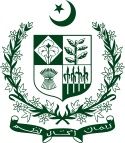
Back الحرية الدينية في باكستان Arabic पाकिस्तान में धार्मिक स्वतंत्रता Hindi パキスタンにおける信教の自由 Japanese ਪਾਕਿਸਤਾਨ ਵਿੱਚ ਧਾਰਮਿਕ ਅਜ਼ਾਦੀ Punjabi پاکستان چ مذہبی آزادی PNB پاکستان میں مذہبی آزادی Urdu
 |
|---|
|
|
Freedom of religion in Pakistan is formally guaranteed by the Constitution of Pakistan for individuals of various religions and religious sects.

Pakistan gained independence in 1947 and was founded upon the concept of two-nation theory. At the time of Pakistan's creation the 'hostage theory' had been espoused. According to this theory the Hindu minority in Pakistan was to be given a fair deal in Pakistan in order to ensure the protection of the Muslim minority in India.[1][2]
| Religion | Population | % |
|---|---|---|
| Muslims ( |
216,563,599 | 96.5% |
| Hindus ( |
4,937,201 | 2.2% |
| Christians ( |
2,693,018 | 1.2% |
| Others (inc. Sikhs, Jews, Jains, Ahmadiyyas, Buddhists, Irreligious) | 224,418 | 0.1% |
| Total | 224,418,238 | 100% |
Pakistan has a population estimated at 224,418,238, as of 2021.[4] In the early 2000s, it was estimated that 96.5% of Pakistanis were Muslims (75-95% Sunni,[5][6][7][8] 5-20% Shia,[5][6][9][10] and 0.22-2.2% Ahmadi,[11] who are not permitted to call themselves Muslims - see Religious discrimination in Pakistan), while the remainder are Hindus, Christians, Sikhs, Zoroastrians, members of other faiths, and agnostics and atheists.[12]
In 2016, Sindh, Pakistan's most religiously diverse province, with 8% religious minority population (predominantly Hindus) passed a bill that outlawed forced conversions. After being passed by the Provincial Assembly, the bill was tabled by a faction of the Pakistan Muslim League called PML-F, Pakistan Muslim League Functional, which in Sindh is led by Sufi leader Pir Pagara.[13][14][15]
- ^ Zamindar, Vazira Fazila-Yacoobali (2010). The Long Partition and the Making of Modern South Asia: Refugees, Boundaries, Histories. Columbia University Press. p. 72. ISBN 9780231138475.
The logic of the hostage theory tied the treatment of Muslim minorities in India to the treatment meted out to Hindus in Pakistan.
- ^ Dhulipala, Venkat (2015). Creating a New Medina: State Power, Islam, and the Quest for Pakistan in Late Colonial North India. Cambridge University Press. p. 19. ISBN 9781316258385.
Within the subcontinent, ML propaganda claimed that besides liberating the 'majority provinces' Muslims it would guarantee protection for Muslims who would be left behind in Hindu India. In this regard, it repeatedly stressed the hostage population theory that held that 'hostage' Hindu and Sikh minorities inside Pakistan would guarantee Hindu India's good behaviour towards its own Muslim minority.
- ^ a b "Religions in Pakistan | PEW-GRF".
- ^ "Pakistan Population (2021) - Worldometer".
- ^ a b "Country Profile: Pakistan" (PDF). Library of Congress Country Studies on Pakistan. Library of Congress. February 2005. Retrieved 1 September 2010.
Religion: The overwhelming majority of the population (96.5%) is Muslim, of whom approximately 95% are Sunni and 5% Shia.
- ^ a b "Religions: Muslim 95% (Sunni 75%, Shia 20%), other". Pakistan (includes Christian and Hindu) 5%. The World Factbook. CIA. 2010. Archived from the original on 17 June 2009. Retrieved 28 August 2010.
- ^ "Mapping the Global Muslim Population: A Report on the Size and Distribution of the World's Muslim Population". Pew Research Center. 7 October 2009. Archived from the original on 27 March 2010. Retrieved 28 August 2010.
- ^ Miller, Tracy, ed. (October 2009). Mapping the Global Muslim Population: A Report on the Size and Distribution of the World's Muslim Population (PDF). Pew Research Center. Archived from the original (PDF) on 10 October 2009. Retrieved 28 August 2010.
- ^ "The World's Muslims: Unity and Diversity". Pew Research Center. 9 August 2012. Retrieved 26 December 2016.
On the other hand, in Pakistan, where 6% of the survey respondents identify as Shia, Sunni attitudes are more mixed: 50% say Shias are Muslims, while 41% say they are not.
- ^ "Field Listing : Religions". The World Factbook. Central Intelligence Agency. 2010. Archived from the original on 17 June 2009. Retrieved 24 August 2010.
- ^ The 1998 Pakistani census states that there are 291,000 (0.22%) Ahmadis in Pakistan. However, the Ahmadiyya Muslim Community has boycotted the census since 1974 which renders official Pakistani figures to be inaccurate. Independent groups have estimated the Pakistani Ahmadiyya population to be somewhere between 2 million and 5 million Ahmadis. However, the 4 million figure is the most quoted figure and is approximately 2.2% of the country. See:
- over 2 million: Immigration and Refugee Board of Canada (4 December 2008). "Pakistan: The situation of Ahmadis, including legal status and political, education and employment rights; societal attitudes toward Ahmadis (2006 - Nov. 2008)". Retrieved 28 June 2012.
- 3 million: International Federation for Human Rights: International Fact-Finding Mission. Freedoms of Expression, of Association and of Assembly in Pakistan. Ausgabe 408/2, January 2005, S. 61 (PDF)
- 3-4 million: Commission on International Religious Freedom: Annual Report of the United States Commission on International Religious Freedom. 2005, S. 130
- 4.910.000: James Minahan: Encyclopedia of the stateless nations. Ethnic and national groups around the world. Greenwood Press. Westport 2002, page 52
- "Pakistan: Situation of members of the Lahori Ahmadiyya Movement in Pakistan". Retrieved 30 April 2014.
- ^ CIA World Factbook.
- ^ Tribune.com.pk (24 November 2016). "Sindh Assembly passes bill against forced religious conversions". The Express Tribune.
- ^ Tribune.com.pk (7 December 2016). "Curbs on forced conversion". The Express Tribune.
- ^ "Bill against forced conversions be resurrected and passed, demand civil society groups". International The News. 24 March 2019.

